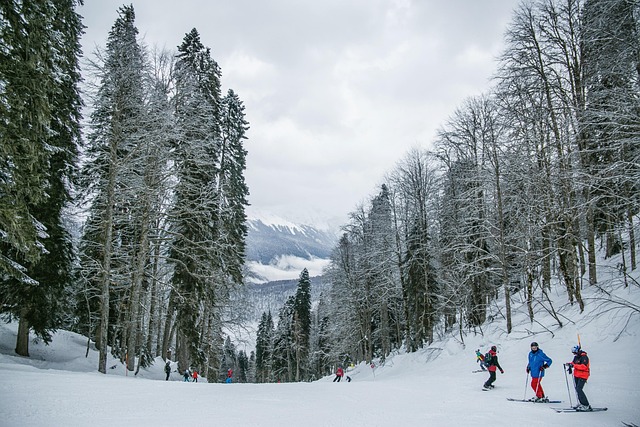Heli-Skiing: The Ultimate Adrenaline Rush for Adventure Seekers
Imagine soaring above pristine, powdery slopes in a helicopter, the anticipation building as you prepare to carve fresh tracks through untouched snow. Heli-skiing, once reserved for elite athletes and the ultra-wealthy, is now emerging as a thrilling option for adventurous travelers seeking the ultimate skiing experience. This exhilarating sport combines the rush of helicopter travel with the challenge of off-piste skiing, offering unparalleled access to remote, backcountry terrain.

Initially, heli-skiing operations were small and exclusive, catering to a select group of skilled skiers and snowboarders. However, as technology improved and safety measures advanced, the sport began to attract a broader audience. Today, heli-skiing has evolved into a global phenomenon, with operations spanning from the Canadian Rockies to the Alps, Alaska, and even the Himalayas.
The Heli-Skiing Experience
What sets heli-skiing apart from traditional resort skiing is the unparalleled access to pristine, backcountry terrain. Participants are flown to remote mountain peaks, far from the crowds and lift lines of conventional ski resorts. This exclusive experience offers several unique advantages:
-
Untouched Powder: Heli-skiers enjoy the thrill of carving through fresh, deep snow that hasn’t been touched by other skiers.
-
Varied Terrain: From wide-open bowls to steep chutes and gladed runs, heli-skiing provides access to diverse landscapes that cater to different skill levels.
-
Small Groups: Most operations limit group sizes, ensuring a more personalized experience and reducing environmental impact.
-
Expert Guidance: Skilled guides lead groups, ensuring safety and helping skiers navigate the challenging terrain.
-
Breathtaking Scenery: The helicopter ride itself offers stunning aerial views of remote mountain landscapes.
Safety and Preparedness
While heli-skiing offers an unparalleled adventure, it also comes with inherent risks. Reputable operators prioritize safety through rigorous protocols and advanced equipment. Before embarking on a heli-skiing trip, participants typically undergo avalanche safety training and are equipped with essential gear such as transceivers, probes, and shovels.
Guides are highly trained in wilderness first aid, avalanche forecasting, and rescue techniques. They carefully assess weather conditions, snow stability, and terrain to minimize risks. Additionally, modern helicopters are equipped with advanced navigation systems and safety features, ensuring safe transport even in challenging mountain environments.
The Environmental Aspect
As with any outdoor activity, heli-skiing has faced scrutiny regarding its environmental impact. Critics argue that the use of helicopters and access to remote areas can disturb wildlife and ecosystems. In response, many operators have implemented sustainable practices:
-
Limited Group Sizes: Smaller groups reduce the impact on fragile alpine environments.
-
Careful Site Selection: Operators rotate skiing areas to prevent overuse of specific locations.
-
Wildlife Considerations: Heli-skiing is often restricted in sensitive habitats during critical times for wildlife.
-
Fuel Efficiency: Modern helicopters are designed for improved fuel efficiency and reduced emissions.
-
Conservation Partnerships: Many heli-skiing companies contribute to local conservation efforts and environmental research.
The Future of Heli-Skiing
As technology continues to advance and sustainability becomes increasingly important, the future of heli-skiing looks promising. emerging trends include:
-
Electric Helicopters: Some companies are exploring the potential of electric or hybrid helicopters to reduce carbon footprints.
-
Virtual Reality Training: VR technology is being used to enhance pre-trip safety training and terrain familiarization.
-
Eco-Lodges: Sustainable, off-grid accommodations are becoming popular for multi-day heli-skiing adventures.
-
Adaptive Heli-Skiing: Programs are being developed to make the sport more accessible to skiers with disabilities.
-
Climate Change Adaptation: Operators are diversifying their offerings to include year-round activities as snow patterns change.
Insider Tips for Your Heli-Skiing Adventure
-
Book early: Popular heli-skiing destinations fill up quickly, especially during peak season.
-
Get in shape: Heli-skiing is physically demanding, so start a fitness regimen well before your trip.
-
Invest in quality gear: Proper equipment is crucial for safety and enjoyment in backcountry conditions.
-
Consider a multi-day package: Longer trips often provide better value and increase your chances of ideal conditions.
-
Don’t forget travel insurance: Ensure your policy covers heli-skiing and potential evacuation costs.
-
Practice your powder technique: Deep snow skiing requires different skills than groomed runs.
-
Listen to your guide: They are experts in reading the terrain and ensuring group safety.
-
Bring a camera: The views and experiences are truly once-in-a-lifetime.
Heli-skiing represents the pinnacle of adventure skiing, offering unparalleled access to pristine wilderness and the thrill of carving through untouched powder. As the sport continues to evolve, balancing excitement with sustainability, it promises to remain a bucket-list experience for adrenaline junkies and powder hounds alike. Whether you’re a seasoned backcountry skier or an adventurous intermediate looking to push your limits, heli-skiing offers a unique blend of luxury, challenge, and natural beauty that is truly hard to match.





